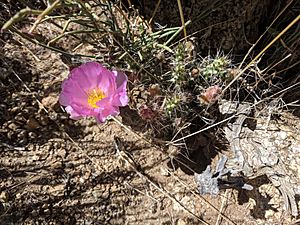Grusonia pulchella facts for kids
Quick facts for kids Grusonia pulchella |
|
|---|---|
 |
|
| Grusonia pulchella | |
| Scientific classification | |
| Genus: |
Grusonia
|
| Species: |
pulchella
|
| Synonyms | |
|
Opuntia pulchella, Corynopuntia pulchella, Micropuntia pulchella, etc. |
|
Grusonia pulchella (pronounced Groo-SOH-nee-uh pul-KEL-uh), also known as the sagebrush cholla, is a unique type of cactus. It's a member of the opuntioid cactus family, which includes many prickly pear cacti. This special plant grows in the dry Mojave Desert region of the United States, found in parts of Nevada, California, Arizona, and Utah.
Scientists have sometimes placed Grusonia pulchella in the Opuntia group or in its own separate group called Micropuntia. What makes it special is its hidden underground storage part, which helps it survive in harsh desert conditions.
Where the Sagebrush Cholla Lives
The sagebrush cholla likes to grow in areas with lots of gravel, especially on alluvial fans. These are fan-shaped deposits of sand and gravel left by flowing water. You can often find them above dry lake beds, called salt flats, or in areas with alkali soil.
Even though they can be common in some spots, Grusonia pulchella can be tricky to find. They often grow hidden under other desert shrubs, like the shadscale plant. This helps protect them from the harsh sun and strong winds.
What the Sagebrush Cholla Looks Like
Grusonia pulchella is different from most other cacti in North America because it has a special way of surviving. Its above-ground parts can die back when conditions are bad, like during a drought. But don't worry, it's not gone for good! It has a hidden "tuber" or storage root underground. This tuber stores water and nutrients, allowing the plant to sprout new growth when the weather improves.
The stems that grow above ground can look different. Some are round, while others are more like cylinders. The plant's areoles, which are small bumps on the stem, have soft, yellow spines and white wool. These spines are flexible, not stiff like some other cacti.
Overall, the parts of the plant you see above ground often form a low, cushion-like shape. When it blooms, the flowers are a beautiful, bright magenta color. After the flowers, it produces fruits that open up to release their seeds. The seeds themselves are unique, with a special groove on one side.

